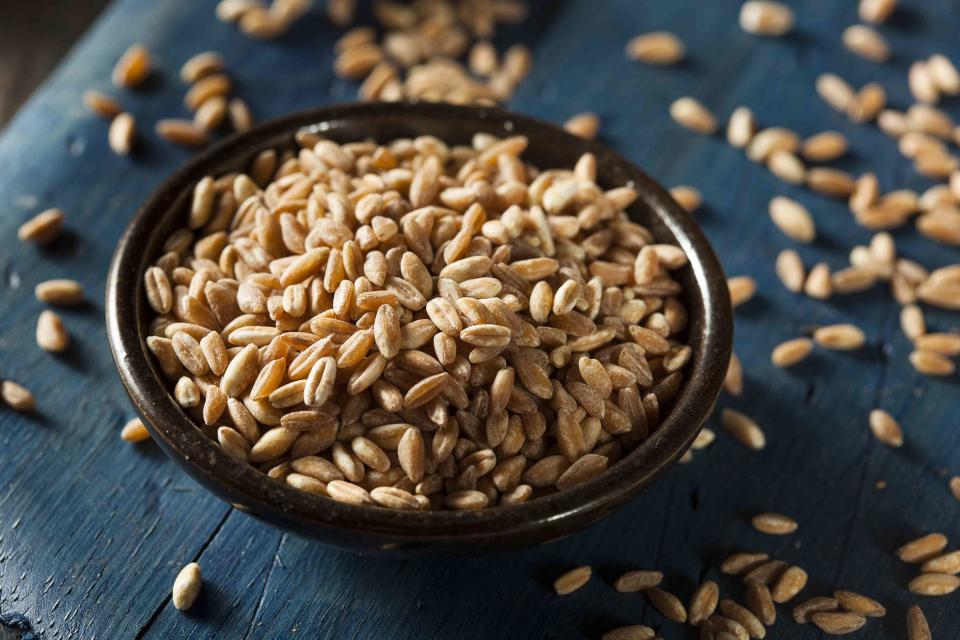How to Cook Farro
Farro is a healthy and versatile whole-grain that is easy to make into grain bowls, risotto, grain salads and more.

bhofack2 / Getty Images
Whether your end goal is a hearty salad or grain bowl, warming side dish for chicken or fish, or sturdy grain addition to soup, farro is a terrific back-pocket whole grain that’s simple, fast and forgiving to cook. We love it in everything from breakfast to dinner. Here are some of our favorite recipes from Farro and Sausage Parmigiano to Farro Breakfast Porridge with Raspberries.
What is farro?
Also known as emmer wheat, farro is an ancient whole-grain wheat that resembles oblong barley. (Note: It is not gluten-free.) Farro is high in fiber and protein, with a magnetically chewy texture and nutty flavor that bears traces of cinnamon. It’s as easy to cook as pasta, though you can prepare it in a few other ways depending on desired active time.
Types of farro
You might run into a few varieties of farro at the supermarket, the main difference being in their level of processing.
Whole farro is the entire grain encased in the bran, which is the tough outer shell that’s a good source of fiber, protein and fat.
Semi-pearled farro is processed to remove some of the bran.
Pearled farro (probably the most common in U.S. grocery stores) has all the bran removed.
Farro with the bran takes longer to cook, unless you soften it by soaking it overnight in the fridge, which trims the cook time down by more than half — meaning lunch in a tight 10 minutes. Because all the bran has been removed from the pearled version, it’s the quickest to cook without soaking. (Regardless though, soaking is nonessential.)
Processed farro is dusty, so it’s generally a good idea to rinse it. If you like a deeper nuttiness in the final product, you can also toast the farro in the pot over medium heat with a little olive oil for about five minutes before adding the liquid, which negates the rinsing step as it also helps tame dust.
Related: 17 Hearty Farro Dishes to Try
How do you cook farro?
If you’re cooking farro on the stove, treat it just like pasta. Bring a generous amount of salted water to a boil (we like a ratio of at least four cups water to one cup farro), add the farro, stir then bring it back up to a boil. (Note: It’s nice to add lemon zest, a dusting of bouillon in place of some of the salt, or a smashed garlic clove to the cooking liquid before you start cooking.) Turn the heat down to a fast simmer, and cook the farro until it’s soft, about 30 minutes. Drain it and serve, or use it in this Farro and Green Olive Salad with Walnuts and Raisins. If you forget it for an extra five minutes, don’t panic. Farro is sturdy enough to maintain a pleasant bounce even when overcooked.
If you prefer a more hands-off approach, consider preparing farro in the oven or in a slow cooker. For oven cooking, preheat to 350°F. Toast the farro in an ovenproof pot, such as a Dutch oven in a little olive oil and salt. Add water, preferably a three-to-one ratio of water to farro in this case, and bring to a simmer. Cover the pot and slide it into the oven. Cook until the farro is soft and chewy, 35 to 45 minutes.
To slow cook, put rinsed or oil-toasted farro into a slow cooker with a pat of butter or glug of olive oil. Add water or broth in a three-to-one ratio to the farro and cook on high until soft and chewy, about 1 ½ hours.
How do you store farro?
Store the leftover cooked farro in an airtight container in the refrigerator, and use it within three days — an easy task with such a satisfying, toothsome grain on hand. Or place in a freezer-safe bag or container and freeze for up to six months.
For more Food & Wine news, make sure to sign up for our newsletter!
Read the original article on Food & Wine.

